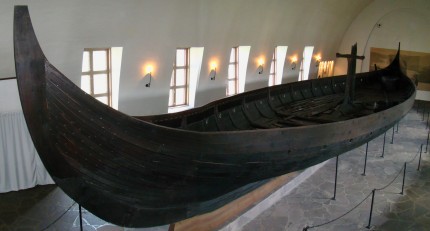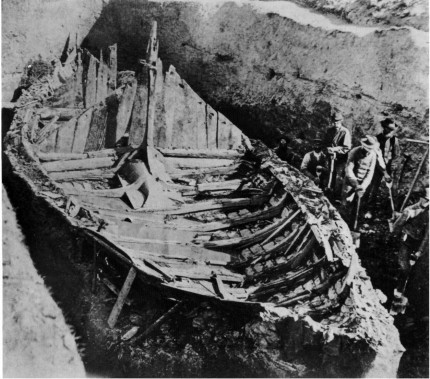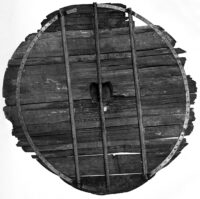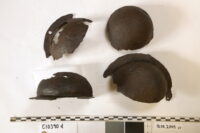The Gokstad ship is the largest preserved Viking ship in Norway and contains an unparalleled quantity and quality of Viking shields. The image of rows of round shields mounted to the exterior of a Viking longship springs directly from the Gokstad discovery.
 The Gokstad ship burial was discovered in 1880 on a farm near Sandefjord, Vestfold, southeastern Norway. The burial mound had been looted for its valuable gold, silver, jewelry and armaments hundreds of years earlier, but the 9th century clinker-built ship was virtually intact, its wood components and contents preserved for a thousand years in the cold, wet soil. The oak timber ship was 76 feet long and 17 feet wide with 16 oar holes on each side of the hull. There was room enough for about 70 people inside. The remains of many wooden treasures which meant nothing to looters but were precious to archaeologists were discovered in the excavation: furniture, a game board, six beds and 64 shields (one for each of the crew, perhaps?).
The Gokstad ship burial was discovered in 1880 on a farm near Sandefjord, Vestfold, southeastern Norway. The burial mound had been looted for its valuable gold, silver, jewelry and armaments hundreds of years earlier, but the 9th century clinker-built ship was virtually intact, its wood components and contents preserved for a thousand years in the cold, wet soil. The oak timber ship was 76 feet long and 17 feet wide with 16 oar holes on each side of the hull. There was room enough for about 70 people inside. The remains of many wooden treasures which meant nothing to looters but were precious to archaeologists were discovered in the excavation: furniture, a game board, six beds and 64 shields (one for each of the crew, perhaps?).
 Wear and tear on the oar ports and the recently-discovered evidence of the youthful footprint carved into the deck indicate the ship was an actual seafaring vessel in active use for at least a decade. It was retired still in working order to serve as a burial for the deceased who must have been of very high status to warrant so fine a conveyance to his final destination.
Wear and tear on the oar ports and the recently-discovered evidence of the youthful footprint carved into the deck indicate the ship was an actual seafaring vessel in active use for at least a decade. It was retired still in working order to serve as a burial for the deceased who must have been of very high status to warrant so fine a conveyance to his final destination.
The ship and its associated archaeological material have been in Oslo’s Viking Ship Museum since 1932. While much scholarship has been done of the ship since it was first published by Norwegian archaeologist Nicolay Nicolaysen in 1882, the shields have been somewhat neglected. Nicolaysen listed them in his publication and included a hypothetical rendering of the ship with its shields, but there has been no in depth research on the material remains of the shields themselves. A few shields were patched together from surviving parts purely for display purposes, but that’s pretty much it.
 The conventional interpretation of the Gokstad ship shields was that they were ceremonial, which is a bit of a fall-back for archaeological artifacts that have no obvious function. Researchers reexamined the shields for the first time in 2019, investigating their construction and shaping for a new reconstruction, and assessing the materials used as a first step in a later comprehensive investigation.
The conventional interpretation of the Gokstad ship shields was that they were ceremonial, which is a bit of a fall-back for archaeological artifacts that have no obvious function. Researchers reexamined the shields for the first time in 2019, investigating their construction and shaping for a new reconstruction, and assessing the materials used as a first step in a later comprehensive investigation.
The study found that the shields were made of tapered wooden planks around a hemispherical central iron boss. On the other side of the boss was a wooden handle (only one of the Gokstad shields’ handles has survived). The shields were painted either yellow or black so when mounted overlapping each other on the ship’s side, they would have looked like alternating yellow and black half-moons. They were fastened to the side of the ship with a cord run through the handles.
 Organic residue on the planks and perforations around the rim of the shields indicate they were probably covered with rawhide, processed and stretched so that it was as thin as parchment allowing the painted wood to show through. The rawhide would have formed a protective layer to strengthen shields in combat. Some notches and marks on the shield bosses may also be evidence they were used in combat, not just hung on the ship in the burial ceremony or to make it look more threatening as a war vessel.
Organic residue on the planks and perforations around the rim of the shields indicate they were probably covered with rawhide, processed and stretched so that it was as thin as parchment allowing the painted wood to show through. The rawhide would have formed a protective layer to strengthen shields in combat. Some notches and marks on the shield bosses may also be evidence they were used in combat, not just hung on the ship in the burial ceremony or to make it look more threatening as a war vessel.
The study has been published in the journal Arms & Armour and may be read in its entirety here.